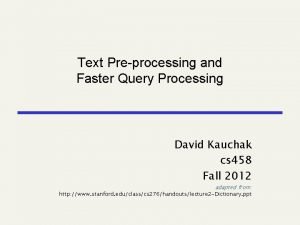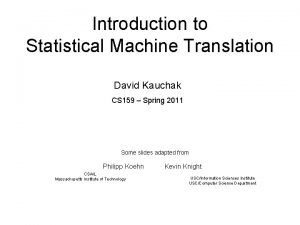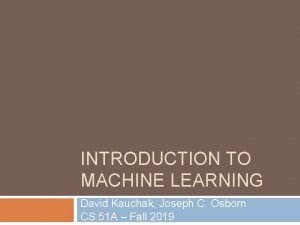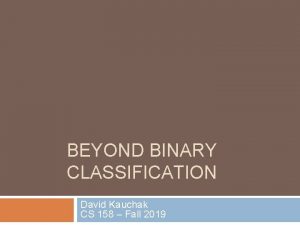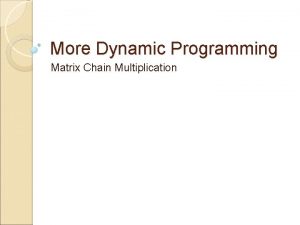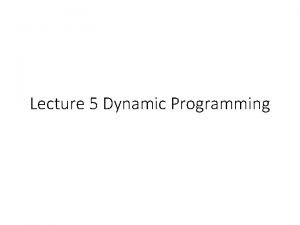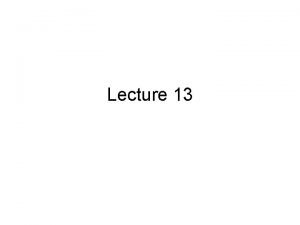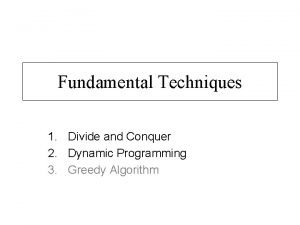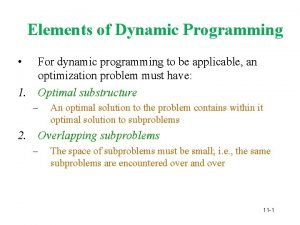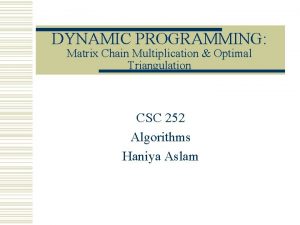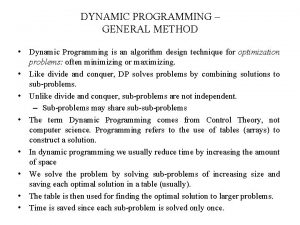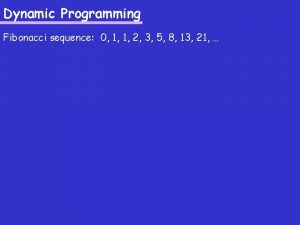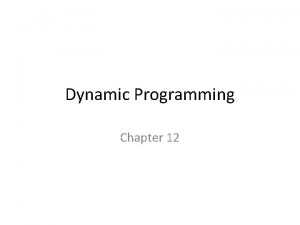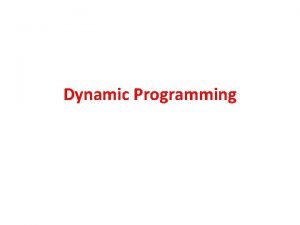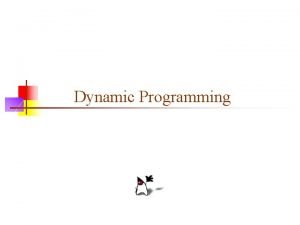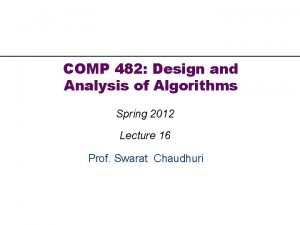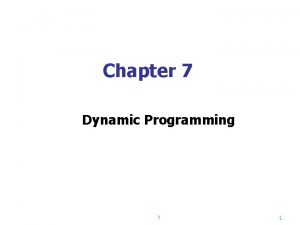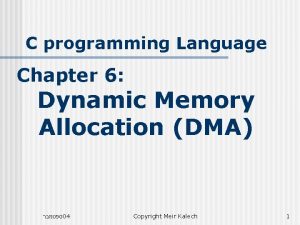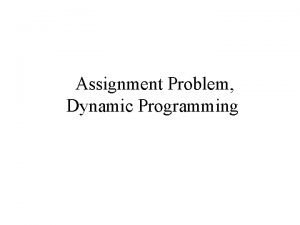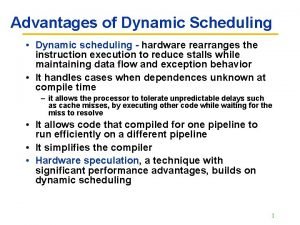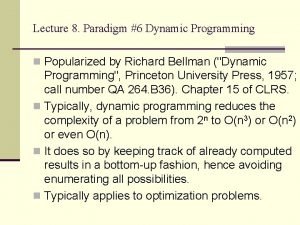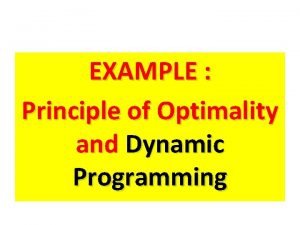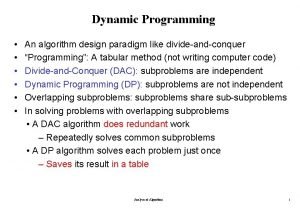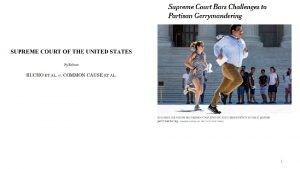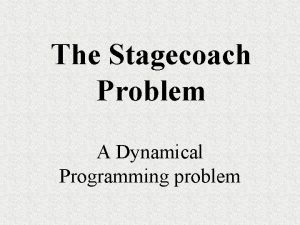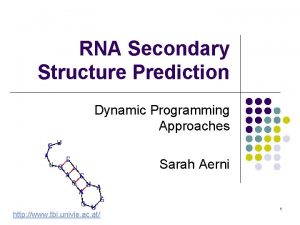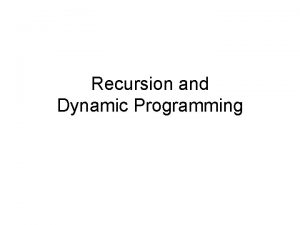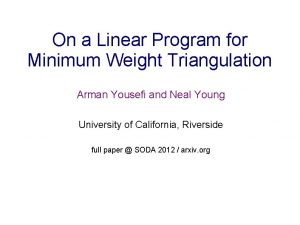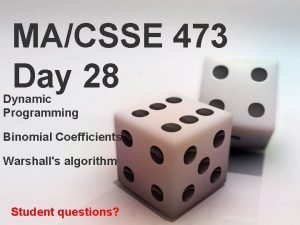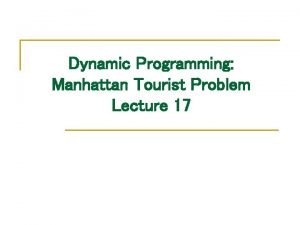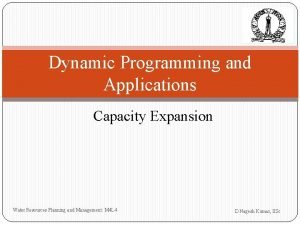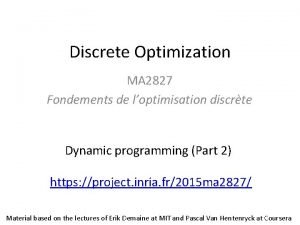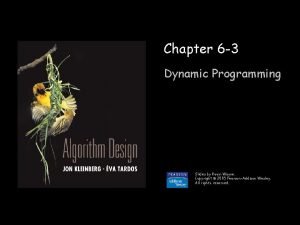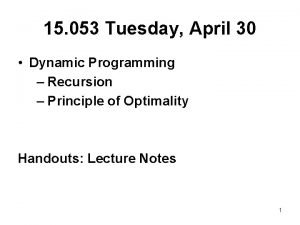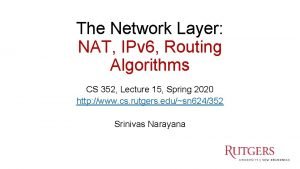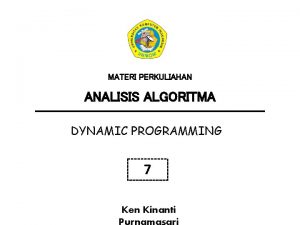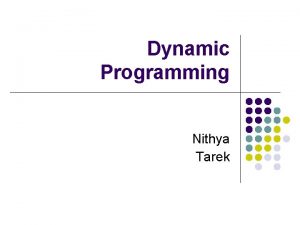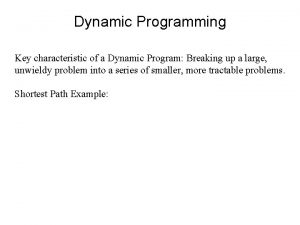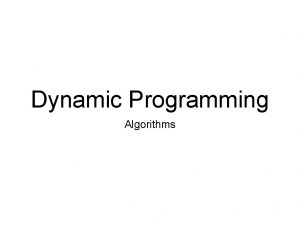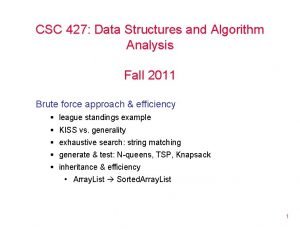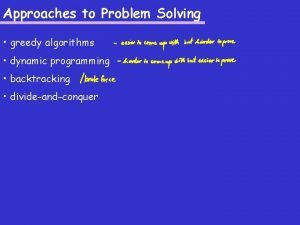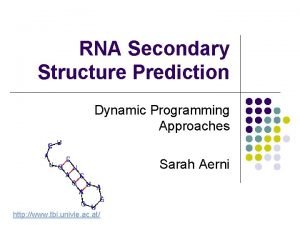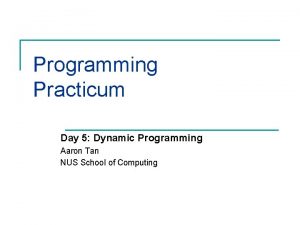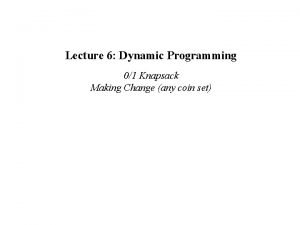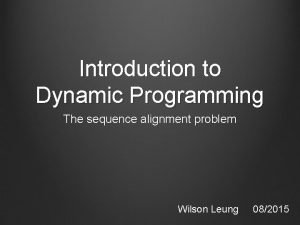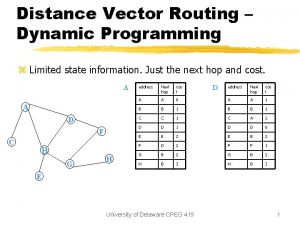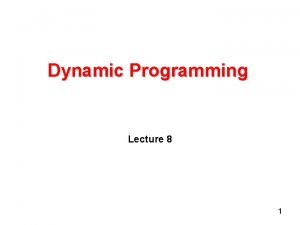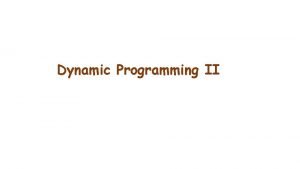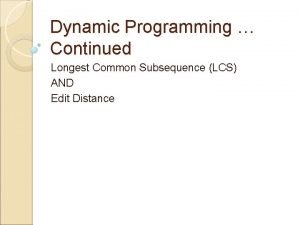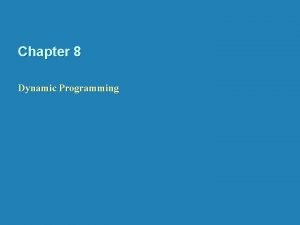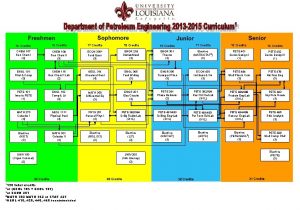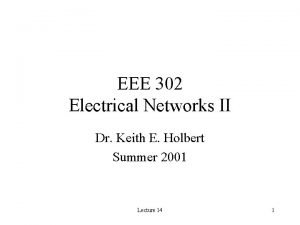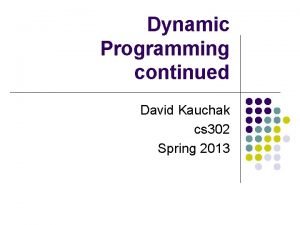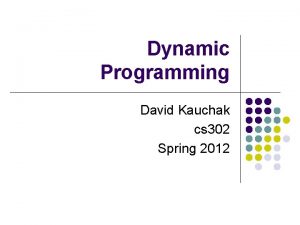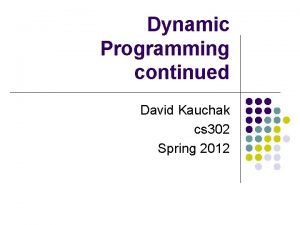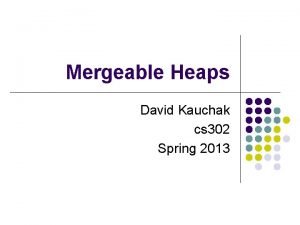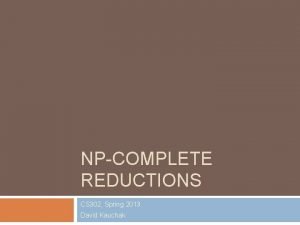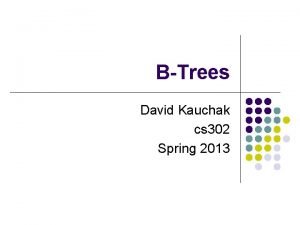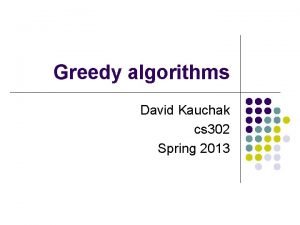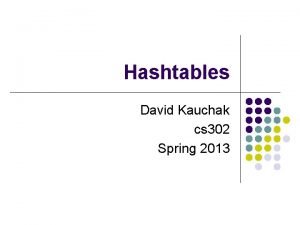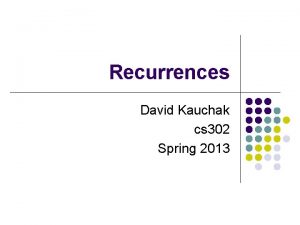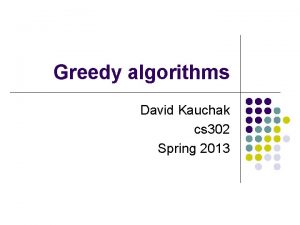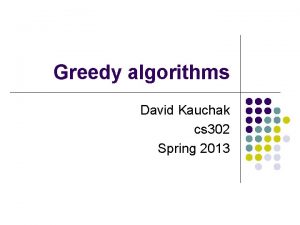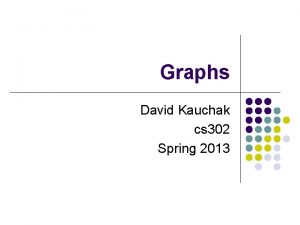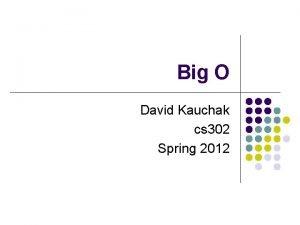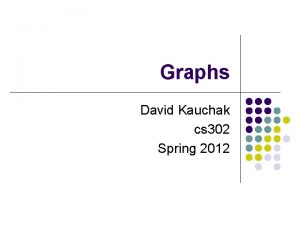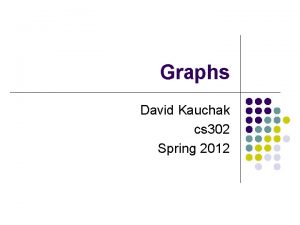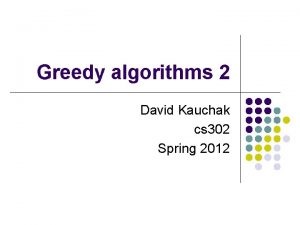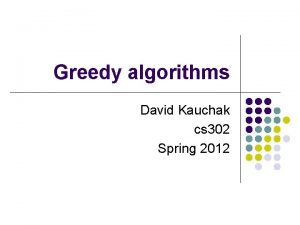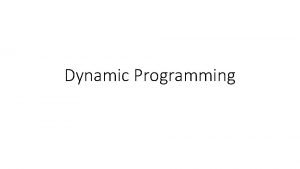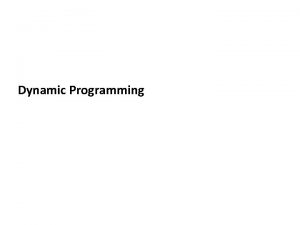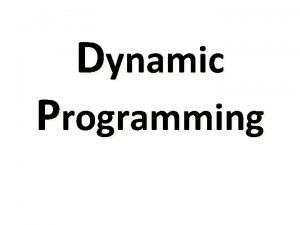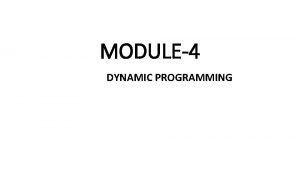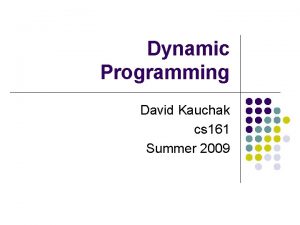Dynamic Programming David Kauchak cs 302 Spring 2013



























![c[0]*c[1] + c[1]*c[0] 1 1 0 1 2 3 4 5 … n c[0]*c[1] + c[1]*c[0] 1 1 0 1 2 3 4 5 … n](https://slidetodoc.com/presentation_image/195888ce8121f66f61c84838429fc2a6/image-28.jpg)
![1 2 2 1 c[0]*c[1] + c[1]*c[0] 1 1 0 1 2 3 4 1 2 2 1 c[0]*c[1] + c[1]*c[0] 1 1 0 1 2 3 4](https://slidetodoc.com/presentation_image/195888ce8121f66f61c84838429fc2a6/image-29.jpg)

![1 2 3 c[0]*c[2] + c[1]*c[1] + c[2]*c[0] 1 1 2 0 1 2 1 2 3 c[0]*c[2] + c[1]*c[1] + c[2]*c[0] 1 1 2 0 1 2](https://slidetodoc.com/presentation_image/195888ce8121f66f61c84838429fc2a6/image-31.jpg)










































- Slides: 73

Dynamic Programming David Kauchak cs 302 Spring 2013

Administative

Dynamic programming One of the most important algorithm tools! Very common interview question Method for solving problems where optimal solutions can be defined in terms of optimal solutions to sub-problems AND the sub-problems are overlapping

Fibonacci numbers 1, 1, 2, 3, 5, 8, 13, 21, 34, … What is the recurrence for the nth Fibonacci number? F(n) = F(n-1) + F(n-2) The solution for n is defined with respect to the solution to smaller problems (n-1 and n-2)

Fibonacci: a first attempt

Is it correct? F(n) = F(n-1) + F(n-2)

Running time Each call creates two recursive calls Each call reduces the size of the problem by 1 or 2 Creates a full binary of depth n O(2 n)

Can we do better? Fib(n) Fib(n-2) Fib(n-1) Fib(n-2) Fib(n-3) Fib(n-4) Fib(n-5) Fib(n-6)

A lot of repeated work! Fib(n) Fib(n-2) Fib(n-1) Fib(n-2) Fib(n-3) Fib(n-4) Fib(n-5) Fib(n-6)

Identifying a dynamic programming problem The solution can be defined with respect to solutions to subproblems The subproblems created are overlapping, that is we see the same subproblems repeated

Overlapping sub-problems divide and conquer dynamic programming …

Creating a dynamic programming solution Step 1: Identify a solution to the problem with respect to smaller subproblems (pretend like you have a solver, but it only works on smaller problems): l F(n) = F(n-1) + F(n-2) Step 2: bottom up - start with solutions to the smallest problems and build solutions to the larger problems use an array to store solutions to subproblems

Is it correct? F(n) = F(n-1) + F(n-2)

Running time? Θ(n)

Counting binary search trees How many unique binary search trees can be created using the numbers 1 through n? 4 2 1 5 3 6

Step 1: What is the subproblem? Assume we have some black box solver (call it T) that can give us the answer to smaller subproblems How can we use the answer from this to answer our question? How many options for the root are there? 1 2 3 … n

Subproblems i How many trees have i as the root?

Subproblems i 1, 2, …, i-1 ? i+1, i+2, …, n

Subproblems i 1, 2, …, i-1 i+1, i+2, …, n T(i-1) ? subproblem of size i-1

Subproblems i 1, 2, …, i-1 T(i-1) i+1, i+2, …, n Number of trees for i+1, i+2, …, i+n is the same as the number of trees from 1, 2, …, n-i

Subproblems i 1, 2, …, i-1 T(i-1) i+1, i+2, …, n T(n-i) Given solutions for T(i-1) and T(n-i) how many trees are there with i as the root?

Subproblems i 1, 2, …, i-1 T(i-1) i+1, i+2, …, n T(n-i) T(i) = T(i-1) * T(n-i)

Step 1: define the answer with respect to subproblems T(i) = T(i-1) * T(n-i)

Is there a problem? As with Fibonacci, we’re repeating a lot of work

Step 2: Generate a solution from the bottom-up

0 1 2 3 4 5 … n

1 1 0 1 2 3 4 5 … n
![c0c1 c1c0 1 1 0 1 2 3 4 5 n c[0]*c[1] + c[1]*c[0] 1 1 0 1 2 3 4 5 … n](https://slidetodoc.com/presentation_image/195888ce8121f66f61c84838429fc2a6/image-28.jpg)
c[0]*c[1] + c[1]*c[0] 1 1 0 1 2 3 4 5 … n
![1 2 2 1 c0c1 c1c0 1 1 0 1 2 3 4 1 2 2 1 c[0]*c[1] + c[1]*c[0] 1 1 0 1 2 3 4](https://slidetodoc.com/presentation_image/195888ce8121f66f61c84838429fc2a6/image-29.jpg)
1 2 2 1 c[0]*c[1] + c[1]*c[0] 1 1 0 1 2 3 4 5 … n

1 1 2 0 1 2 3 4 5 … n
![1 2 3 c0c2 c1c1 c2c0 1 1 2 0 1 2 1 2 3 c[0]*c[2] + c[1]*c[1] + c[2]*c[0] 1 1 2 0 1 2](https://slidetodoc.com/presentation_image/195888ce8121f66f61c84838429fc2a6/image-31.jpg)
1 2 3 c[0]*c[2] + c[1]*c[1] + c[2]*c[0] 1 1 2 0 1 2 3 4 5 … n

1 1 2 5 0 1 2 3 4 5 … n

1 1 2 5 … 0 1 2 3 4 5 … n

Running time? Θ(n 2)

Longest common subsequence (LCS) For a sequence X = x 1, x 2, …, xn, a subsequence is a subset of the sequence defined by a set of increasing indices (i 1, i 2, …, ik) where 1 ≤ i 1 < i 2 < … < i k ≤ n X=ABACDABAB ABA?

Longest common subsequence (LCS) For a sequence X = x 1, x 2, …, xn, a subsequence is a subset of the sequence defined by a set of increasing indices (i 1, i 2, …, ik) where 1 ≤ i 1 < i 2 < … < ik ≤ n X=ABACDABAB ABA

Longest common subsequence (LCS) For a sequence X = x 1, x 2, …, xn, a subsequence is a subset of the sequence defined by a set of increasing indices (i 1, i 2, …, ik) where 1 ≤ i 1 < i 2 < … < i k ≤ n X=ABACDABAB ACA?

Longest common subsequence (LCS) For a sequence X = x 1, x 2, …, xn, a subsequence is a subset of the sequence defined by a set of increasing indices (i 1, i 2, …, ik) where 1 ≤ i 1 < i 2 < … < i k ≤ n X=ABACDABAB ACA

Longest common subsequence (LCS) For a sequence X = x 1, x 2, …, xn, a subsequence is a subset of the sequence defined by a set of increasing indices (i 1, i 2, …, ik) where 1 ≤ i 1 < i 2 < … < i k ≤ n X=ABACDABAB DCA?

Longest common subsequence (LCS) For a sequence X = x 1, x 2, …, xn, a subsequence is a subset of the sequence defined by a set of increasing indices (i 1, i 2, …, ik) where 1 ≤ i 1 < i 2 < … < i k ≤ n X=ABACDABAB DCA

Longest common subsequence (LCS) For a sequence X = x 1, x 2, …, xn, a subsequence is a subset of the sequence defined by a set of increasing indices (i 1, i 2, …, ik) where 1 ≤ i 1 < i 2 < … < i k ≤ n X=ABACDABAB AADAA?

Longest common subsequence (LCS) For a sequence X = x 1, x 2, …, xn, a subsequence is a subset of the sequence defined by a set of increasing indices (i 1, i 2, …, ik) where 1 ≤ i 1 < i 2 < … < i k ≤ n X=ABACDABAB AADAA

LCS problem Given two sequences X and Y, a common subsequence is a subsequence that occurs in both X and Y Given two sequences X = x 1, x 2, …, xn and Y = y 1, y 2, …, yn, What is the longest common subsequence? X=ABCBDAB Y=BDCABA

LCS problem Given two sequences X and Y, a common subsequence is a subsequence that occurs in both X and Y Given two sequences X = x 1, x 2, …, xn and Y = y 1, y 2, …, yn, What is the longest common subsequence? X=ABCBDAB Y=BDCABA

Step 1: Define the problem with respect to subproblems X=ABCBDAB Y=BDCABA Assume you have a solver for smaller problems

Step 1: Define the problem with respect to subproblems X=ABCBDA? Y=BDCAB? Is the last character part of the LCS?

Step 1: Define the problem with respect to subproblems X=ABCBDA? Y=BDCAB? Two cases: either the characters are the same or they’re different

Step 1: Define the problem with respect to subproblems X=ABCBDAA LCS Y=BDCABA If they’re the same The characters are part of the LCS What is the recursive relationship?

Step 1: Define the problem with respect to subproblems X=ABCBDAB LCS Y=BDCABA If they’re different

Step 1: Define the problem with respect to subproblems X=ABCBDAB LCS Y=BDCABA If they’re different

Step 1: Define the problem with respect to subproblems X=ABCBDAB Y=BDCABA If they’re different ?

Step 1: Define the problem with respect to subproblems X=ABCBDAB Y=BDCABA (for now, let’s just worry about counting the length of the LCS)

Step 2: Build the solution from the bottom up What types of subproblem solutions do we need to store? LCS(X 1…j, Y 1…k) two different indices

Step 2: Build the solution from the bottom up What types of subproblem solutions do we need to store? LCS(X 1…j, Y 1…k)

j i 0 1 2 3 4 5 6 7 xi A B C B D A B 0 1 2 34 5 6 yj B D C A B A For Fibonacci and tree counting, we had to initialize some entries in the array. Any here?

j i 0 1 2 3 4 5 6 7 xi A B C B D A B 0 1 2 34 5 6 yj B D C A B A 0 000 0 Need to initialize values within 1 smaller in either dimension. 0 0 0

j i 0 1 2 3 4 5 6 7 xi A B C B D A B 0 1 2 34 5 6 yj B D C A B A 0 000 0 0 ? 0 0 0 LCS(A, B)

j i 0 1 2 3 4 5 6 7 xi A B C B D A B 0 1 2 34 5 6 yj B D C A B A 0 000 0 0 0 0

j i 0 1 2 3 4 5 6 7 xi A B C B D A B 0 1 2 34 5 6 yj B D C A B A 0 000 0 0 0? 0 0 0 LCS(A, BDCA)

j i 0 1 2 3 4 5 6 7 xi A B C B D A B 0 1 2 34 5 6 yj B D C A B A 0 000 0 0 01 0 0 0 LCS(A, BDCA)

j i 0 1 2 3 4 5 6 7 xi A B C B D A B 0 1 2 34 5 6 yj B D C A B A 0 0 0 0 0 1 1 1 000 011 112 22? 0 1 2 2 LCS(ABCB, BDCAB)

j i 0 1 2 3 4 5 6 7 xi A B C B D A B 0 1 2 34 5 6 yj B D C A B A 0 0 0 0 0 1 1 1 000 011 112 223 0 1 2 2 LCS(ABCB, BDCAB)

j i 0 1 2 3 4 5 6 7 xi A B C B D A B 0 1 2 34 5 6 yj B D C A B A 0 0 0 0 0 1 1 1 2 2 2 000 011 112 223 223 234 0 1 2 2 3 3 4 4 Where’s the final answer?

The algorithm

The algorithm Base case initialization

The algorithm Fill in the matrix

The algorithm

The algorithm

The algorithm

Running time? Θ(nm)

Keeping track of the solution Our LCS algorithm only calculated the length of the LCS between X and Y What if we wanted to know the actual sequence? Keep track of this as well…

j i 0 1 2 3 4 5 6 7 xi A B C B D A B 0 1 2 34 5 6 yj B D C A B A 0 0 0 0 0 1 1 1 2 2 2 000 011 112 223 223 234 0 1 2 2 3 3 4 4 We can follow the arrows to generate the solution

j i 0 1 2 3 4 5 6 7 xi A B C B D A B 0 1 2 34 5 6 yj B D C A B A 0 0 0 0 0 1 1 1 2 2 2 000 011 112 223 223 234 0 1 2 2 3 3 4 4 We can follow the arrows to generate the solution BCBA
 Cs 451
Cs 451 David kauchak
David kauchak David kauchak
David kauchak David kauchak
David kauchak David kauchak
David kauchak David kauchak
David kauchak David kauchak
David kauchak Greedy programming vs dynamic programming
Greedy programming vs dynamic programming Introduction to teaching 6th edition
Introduction to teaching 6th edition Cast of spring, summer, fall, winter... and spring
Cast of spring, summer, fall, winter... and spring Spring winter summer fall months
Spring winter summer fall months Spring 아이디 찾기 소스
Spring 아이디 찾기 소스 Transferered
Transferered Tabulation dynamic programming
Tabulation dynamic programming Matrix chain multiplication algorithm
Matrix chain multiplication algorithm A b a b c d e
A b a b c d e Dynamic programing
Dynamic programing Dynamic programming bottom up
Dynamic programming bottom up What are the elements of dynamic programming
What are the elements of dynamic programming Dynamic programming vs divide and conquer
Dynamic programming vs divide and conquer Dynamic programming general method
Dynamic programming general method Dynamic programming excel
Dynamic programming excel Fibonacci sequence dynamic programming
Fibonacci sequence dynamic programming Egg drop algorithm
Egg drop algorithm Top down greedy approach
Top down greedy approach Dynamic programming algorithm
Dynamic programming algorithm Segmented least squares dynamic programming
Segmented least squares dynamic programming Multistage graph example
Multistage graph example Dma dynamic memory allocation
Dma dynamic memory allocation Assignment problem dynamic programming
Assignment problem dynamic programming Benefits of dynamic scheduling software
Benefits of dynamic scheduling software Advanced dynamic programming
Advanced dynamic programming Knapsack dynamic programming
Knapsack dynamic programming Dynamic programming paradigm
Dynamic programming paradigm Principle of optimality in algorithm
Principle of optimality in algorithm Dynamic programming paradigm
Dynamic programming paradigm Disadvantages of dynamic array
Disadvantages of dynamic array Gerrymandering dynamic programming
Gerrymandering dynamic programming Stage coach problem
Stage coach problem Canonical base
Canonical base Recursion vs dynamic programming
Recursion vs dynamic programming Minimum weight triangulation dynamic programming
Minimum weight triangulation dynamic programming Binomial coefficient using dynamic programming
Binomial coefficient using dynamic programming Manhattan problem
Manhattan problem Dynamic programming recursion example
Dynamic programming recursion example Discrte
Discrte Dynamic programming slides
Dynamic programming slides Bh&m
Bh&m Dynamic programming equation
Dynamic programming equation Dynamic programming
Dynamic programming Dynamic programming
Dynamic programming Characteristics of dynamic programming
Characteristics of dynamic programming Dynamic programming in excel
Dynamic programming in excel Levenshtein distance for oslo-snow
Levenshtein distance for oslo-snow Dynamic programming
Dynamic programming Dynamic programming
Dynamic programming Rna secondary structure dynamic programming
Rna secondary structure dynamic programming Dynamic programming
Dynamic programming Binomial coefficient excel
Binomial coefficient excel Global alignment problem
Global alignment problem Programingz
Programingz Dynamic programming history
Dynamic programming history Parenthesization
Parenthesization Edit distance dynamic programming
Edit distance dynamic programming Floyd warshall algorithm transitive closure
Floyd warshall algorithm transitive closure Perbedaan linear programming dan integer programming
Perbedaan linear programming dan integer programming Definition of system programming
Definition of system programming Linear vs integer programming
Linear vs integer programming Perbedaan linear programming dan integer programming
Perbedaan linear programming dan integer programming 7285 x 302
7285 x 302 A 302
A 302 Mat 302 bmcc
Mat 302 bmcc Definition of growth and development
Definition of growth and development Eee 302
Eee 302

